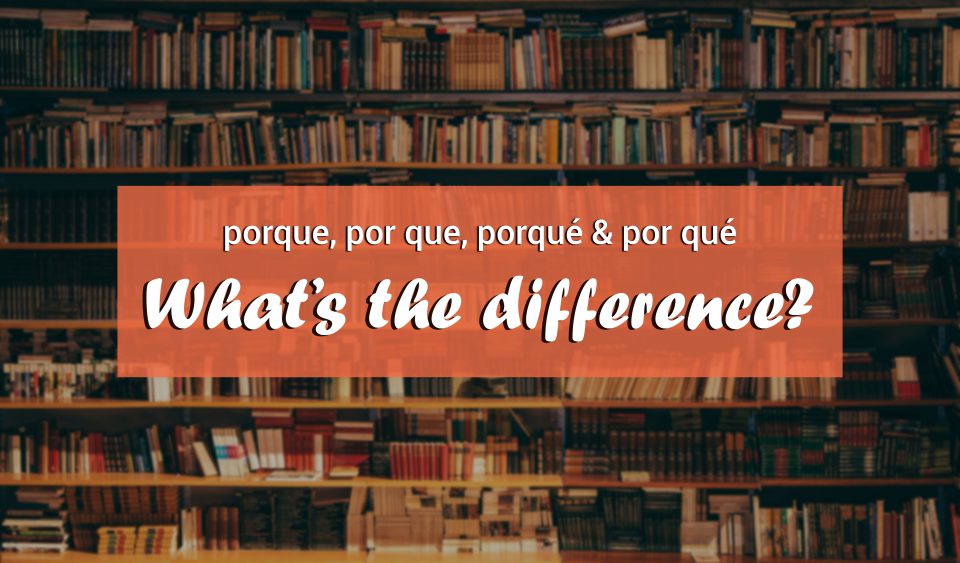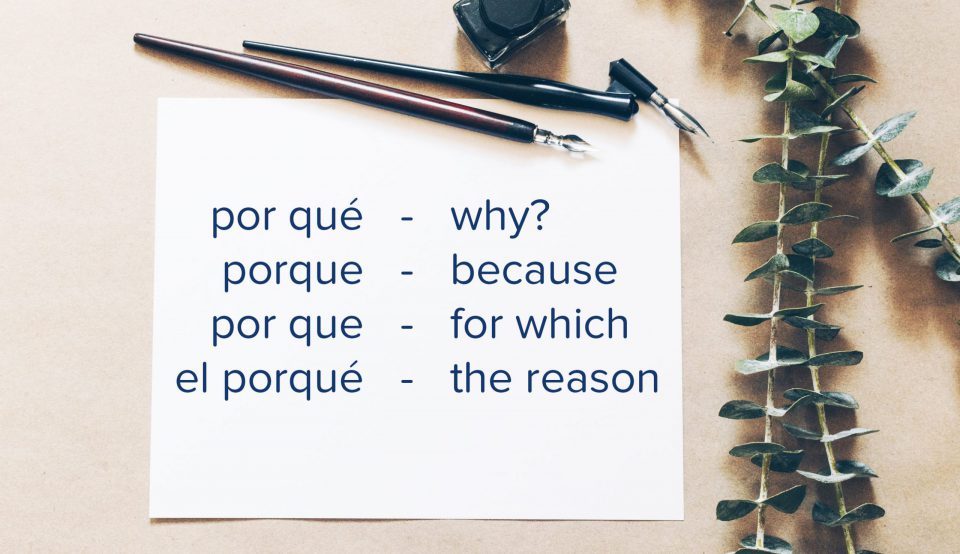How to Say I Love You in Hungarian
Caught up in the rapture of love? We’ve got your back.
Let’s settle this once and for all and see what's the difference between the four porques.

Porque vs por que and porqué vs por qué: the real Clash of the Titans, the ultimate mystery of our world. What’s the difference and how do you correctly use all these porques in Spanish? Well, buckle up because today you are finally going to find out and, most importantly, glue into your brain for eternity, the answers you’ve been looking for.
Essentially, porque, por que, porqué and por qué are all pronounced the same (with some minor differences related to emphasis), but they mean totally different things. While porque translates to “because”, por que translates to “for which”, el porqué to “the reason” and por qué to “why”. It’s obviously incredibly easy to change the whole meaning of a sentence with a single misplaced Spanish accent.
If you are an English speaker, you know that’s not new. We also have our struggles with “your” and “you’re”, “whose” and “who’s”, “these” and “this”. Even if you know English to perfection, sometimes your brain just goes blank and you don’t know what’s the correct form anymore. But the porque, por que, porqué and por qué problem seems even more complicated than that. So read on to discover rules, eloquent examples in Spanish and the correct Spanish pronunciation for each situation.
Let’s start with the two most common porques: por qué and porque – “why?” and “because” – the question and the answer.
Although you may be confused right now with all these versions of – basically – the same word, this por qué will always be written in two words and an accent over “e” when you want to ask a question: “why?”. Let’s add the distinctive Spanish question marks and see some examples:
Now let’s see some examples where por qué is used as a reported or indirect question. Here are some examples to help you understand better:

As you already know, whenever you ask “why?” in English, the other person will probably begin their answer using “because”. Well, Spanish has the same rules: whenever you ask someone “por qué”, they will probably begin their answer with the plain and simple “porque” with no spaces and no accents. Let’s see some examples:
In other cases, “because” and “porque” can become the subordinating conjunctions that link two clauses: the reason and the result. Let’s see some examples to help you better understand:
Well, this was the easy part of the great mystery behind porque vs por que. Lucky for those of us who want to learn Spanish, the simplest porques are also the most frequently used.
But it’s always better to be safe and learn all the possible outcomes than learn only half of them and feel sorry afterwars. So let’s move on to the more problematic porques: por que (for which) and el porqué (the reason).
The knottiest of the four porques is definitely the por que that translates to “for which”. Even in English we rarely use this word arrangement in a sentence.
Let’s look at “this is the jacket for which I was looking”. That doesn’t sound exactly natural, does it? A more logical way to express the same information would be “this is the jacket I was looking for”. But Spanish can’t end a sentence with a preposition. So let’s explore the two situations where you’ll need to use “por que”.
While in the original Spanish sentence la razón por que can be replaced with por la que / por la cual, in the English translation, “the reason why” can always take the place of “the reason for which”. Same goes for the second example: el motivo por que can be replaced with el motivo por el que / por el cual. In day-to-day conversations in Spanish, people are more likely to use the more natural forms: por la/el que, por la/el cual.
Another possible situation where you’ll need to use por que is when you’ll have phrasal verbs like abogar por (advocate for), preocupar por (worry about) or luchar por (fight for) followed by “que”.
Well, now it’s all starting to make sense, doesn’t it?

Bare with me. This is the last “porqué” and the easiest “porqué”.
El porqué usually translates to “the reason”, but it can also mean “why” – used as a noun. Here’s an example from Simon Sinek: “Everybody has a WHY. Do you know yours?”. In Spanish, that would translate to “Todos tienen un PORQUÉ. ¿Conoces el tuyo?”. Here are a few more examples with el porqué:
Officially, the four porques are no longer a mystery for you. Yey!
Now, if you want to unravel even more secrets about the Spanish language, you can also check our in-depth articles Spanish verbs and Spanish accents.
Do you want to practice what you’ve learned about the four porques? Check Mondly, the revolutionary language learning platform that makes language learning fun, fast and easy!
Mondly is a pocket-held language tutor that allows you to put your brain on autopilot and enjoy the ride to fluency in 33 languages. By combining solid neural science, cutting edge technologies, bite-sized Daily Lessons and a gamified experience guaranteed to make you addicted to learning languages, Mondly gets you fluent faster than you could ever imagine.
It all goes like this: if you like to play games, you will love Mondly. Each lesson, regardless of the language or languages you want to learn, is designed to beef up your knowledge little by little and shape you into a better, more natural speaker.
Besides, there are NO computer-generated voices in Mondly. All the recordings are made with fluent speakers so you can learn only from the best from the comfort of your own home. All these while also avoiding the fear of embarrassing yourself by practicing conversations with a fluent speakers.
Start using Mondly for free on your computer or tablet or, better yet, download the Mondly app on your iOS or Android device and learn languages fast anytime, anywhere.
Do you want to learn Spanish with Mondly in only 2 minutes a day?

Caught up in the rapture of love? We’ve got your back.

Did you know that 100 Vietnamese words account for 50% of any communication in Vietnamese?

Previously also known as Ruthenian, Ukrainian is an East Slavic language of the Indo-European language family.